Feature
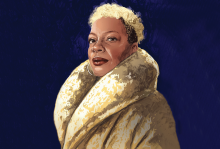
AUNJANUE ELLIS-TAYLOR, known for such roles as Hippolyta Freeman in the HBO series Lovecraft Country and Mama in The Color Purple (2023), approaches her acting as an artisan, searching for the right tools with which to craft her characters, she told Sojourners’ assistant editor Josina Guess this spring. Two recent films — Origin (2023) and Exhibiting Forgiveness (2024) — feature powerful performances by Ellis-Taylor and tap into her own yearning for a world in which justice and truth prevail.
Origin (written, produced, and directed by Ava DuVernay) is a biographical drama inspired by Pulitzer-winning journalist Isabel Wilkerson’s process of writing Caste: The Origins of Our Discontents (2020). The film depicts a quest for the origins of why we separate ourselves from one another, even though it destroys us physically, spiritually, and politically. For her moving performance as Wilkerson, Ellis-Taylor traveled to Germany and India, tracing Wilkerson’s observations about the connected histories between Nazism, the caste system, and racism in the United States — deepening our understanding of these bitter human wounds.
Exhibiting Forgiveness is an autobiographical film written and directed by artist Titus Kaphar, whose process-oriented works on canvas, sculpture, and film reveal the layered reality between history and the present. In Exhibiting Forgiveness, an artist named Tarrell experiences rising success while haunted by flashbacks of a childhood riddled with addiction and family violence. Ellis-Taylor plays Joyce, the artist’s mother, who begs her son to forgive because “it’s what the Bible says.”
Both films invite viewers to wrestle with themes of reckoning and healing on a personal and societal level. Ellis-Taylor spoke with Guess about the lessons of Origin in this election year, what she sees as the “burdensome” work of Black forgiveness in the face of ongoing harm, and her commitment to speaking and living into truth, including embracing her queer identity while remaining in the Black church. —The Editors
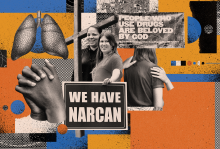
“WE ARE IN the midst of an overdose crisis,” said Hill Brown, southern director of Faith in Harm Reduction. “We say overdose crisis and not opioid crisis because right now overdose is the crisis. We’ve had opioids forever.”
In 2020 and 2021, during the height of deaths and extreme social isolation from COVID-19, deaths from overdoses surged in the United States before reaching a new baseline. The CDC estimates nearly 110,000 overdose deaths in the 12 months ending November 2023. That’s up from 71,350 deaths in the 12 months ending November 2019. Nearly 70 percent of these deaths were related to fentanyl and other synthetic opioids. For people 35 to 64 years old, the overdose death rate was highest among Black men and American Indian/Native Alaskan men at around 60 per 100,000 persons. Overdoses have become the third largest cause of death among teens 14 to 18 years of age, behind firearm deaths and vehicle collisions, rising to an average of 22 per week in 2022, largely driven by fentanyl in counterfeit prescription pills.
While churches have long hosted recovery groups focused on abstinence from drugs, some faith leaders are exploring how churches and other religious institutions can serve people who use drugs (PWUDs). By offering safer drug use resources such as sterile syringes and smoking supplies, fentanyl test strips, safe consumption sites, naloxone (an overdose reversal drug) training, and counseling, they are also working to extend this welcome and compassion without moralizing about drug use or judging PWUDs.
Collectively known as harm reduction, these practices were originally envisioned as strategies to curtail the spread of HIV. In this context, harm reduction aims to reduce the negative consequences associated with drug use. Its values include viewing PWUDs as sacred and beloved, believing love is greater than the law, allowing PWUDs to exercise choice, and centering a person-first approach that embodies compassion, dignity, and justice.
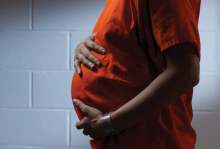
KADIJA CLIFTON LEARNED she was pregnant with her second child while being booked at a Maryland county jail. She had no idea that she was expecting. She was halfway through her pregnancy before she got her first ultrasound. On that day, two armed sheriffs escorted her to the medical facility with her wrists cuffed in front of her belly. A female correctional officer sat in the corner of the room while she was being examined. Clifton felt she had no privacy — “it was invasive and not fun at all.”
Clifton, who has been out for several years and is raising her son with her parents’ support, recalls that she spent the rest of her pregnancy in the county jail worrying about the health of her unborn child. She was already anxious about leaving her then 5-year-old daughter to be raised by her ex. The news of the pregnancy made things even more complicated.
“During those months I remember simply wanting a comfortable place to sit, versus plastic chairs or stools with no back support. I was seriously pregnant,” says Clifton. “Then there was the food, or lack of it. You have a limited amount. You get three meals a day, and if you are pregnant, it is just not enough.” Luckily, by the time Clifton was due, she was able to pay the bail bond and was awaiting trial at home.
I first met Clifton at a graduation ceremony in Alexandria, Va., for Together We Bake, a workforce training program. Clifton shared her life story in front of a handmade collage while hugging her then-5-year-old son. She had completed a 10-week training, learning about food safety, business administration, job readiness, and other critical life skills. Two months later, she became a senior adviser to a podcast on reentry I was producing at the time. Clifton now works as a night supervisor in a facility that hosts at-risk LGBTQI+ youth. Her daughter, now 14, still lives with her dad, but she and Clifton speak regularly.
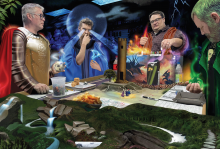
“ONE OF THE TRADITIONS of St. Patrick is an old prayer that he wrote called ‘St. Patrick’s Breastplate,’” explained Father David Rose of St. Luke’s Episcopal Church in Rincon, Ga., to the half-dozen men who’d gathered around him. “It’s more like an epic poem, like an old epic Celtic poem, but it’s a prayer.”
“I bind unto myself today / the strong Name of the Trinity,” he continued, reciting stanzas of the 1,500-year-old prayer. “By invocation of the same / The Three in One and One in Three / Of Whom all nature hath creation / Eternal Father, Spirit, Word: Praise to the Lord of my salvation / Salvation is of Christ the Lord!”
Father Rose wasn’t addressing his fellows from the pulpit, however, nor were they gathered in the basement or rectory of St. Luke’s. Instead, he was speaking to a group of Dungeons & Dragons players at Savannah Lion Games in Pooler, Ga., at a table covered in rulebooks and dice rather than Bibles and hymnals.
Welcome to Game Church.
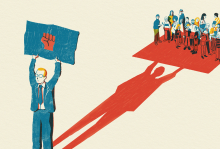
Editor’s note: A version of this article first appeared on sojo.net on Jan. 9, 2024 as “What DEI Trainings and Evangelical Retreats Have in Common.”
JONATHAN TRAN TELLS a story he encountered while researching his book Asian Americans and the Spirit of Racial Capitalism, about Chinese immigrants who lived in the Mississippi Delta during the Reconstruction period. After the Civil War, Tran says, white people not only prevented Black people from living in certain neighborhoods and attending schools with their white children — they discriminated similarly against people of Chinese descent.
But dissimilar to the Delta’s Black population, the Chinese immigrants were able to open modest grocery stores, which allowed them to accumulate wealth thanks to Black patronage. In this way, the Delta Chinese immigrants saw their material conditions improve — but this improvement came under a system of white supremacy, which necessitated the exclusion of the Delta’s Black population.
Tran tells this story to demonstrate the ways that capitalism and white supremacy have become intertwined. In a nod to the Black radical tradition, Tran refers to this system as racial capitalism. The account also demonstrates Tran’s commitment to storytelling. He doesn’t explain the negative effects of racial capitalism in a removed or abstract way; rather, he leans into the complicated histories that have pitted racially marginalized groups against one another.
Tran, an associate dean of Baylor University’s Honors College and an associate professor of theology, understands how stories are influenced by material reality — which is why, for Tran, criticism of racism that does not also include a critique of the capitalist system is wrong-headed. But Tran doesn’t just critique racial capitalism or anti-racist enterprises that avoid economics. Tran believes that Christian theology offers an alternative story to racial capitalism, one that finds its locus in the “divine economy.”
Tran talked with sojo.net associate opinion editor Josiah R. Daniels last fall about Christian theology, anti-racism, W.E.B. Du Bois, and what it means to live into a reconstructed reality. — The Editors

“IN THE BEGINNING was the Word and the Word was with God and the Word was God.” I had no idea what the words I recited in front of the church meant. My Mary Janes hurt my feet and my dress was so tight it left angry red welts in my armpits. Mom looked so proud; Dad, too, sitting in the front row, smiling. I didn’t want to disappoint them, especially here.
As far back as I can remember, my parents started churches in our suburban Milwaukee home. They were nondenominational, Independent, Calvinist, Fundamentalist Baptist. Initially, just a few families gathered, with Dad leading the service in our living room. Before long, our house overflowed, and the adults started raising money to construct a church. Once the building was complete, dissension began and my parents would leave, claiming the church was now too liberal. They disapproved of so many things: changes to the prayer book, Black people joining their all-white communities, homosexuality, women in ministry, the Equal Rights Amendment, anyone who questioned the literal translation of the Bible, adding rhythm to traditional hymns, accepting Catholics as fellow Christians. We were the “Chosen.” Predestined and proud of it.
My parents were also active members of The John Birch Society (JBS), the extreme right political organization, founded in 1958, which is known to be racist and antisemitic. They hosted monthly JBS chapter meetings in our living room. It was hard to know which belief system drove them more: the conservative politics of the JBS or the fundamentalist Christian fear of the rise of the Antichrist. Either way, to them the possibility of a communist invasion was a real threat.
They hired a handyman to build a hidey-hole in the back of the closet in our basement, where our whole family could hunker down if communists invaded the United States. Because we were Christians, educated, and part of the ruling class, Mom told us our family would be among the first to be imprisoned, then executed. Most of my nightmares as a child involved communists finding us in our hiding place.
I grew up listening to Mom and her friends, drinking coffee around our kitchen table while they animatedly discussed which group of people was ruining our country and if former President Dwight D. Eisenhower was really a communist agent.
I never quite understood what all the fuss was about. All I knew was that I adored listening to my Dad talk about politics and preach. I loved memorizing the verses he gave me about fleeing evil and avoiding temptation. I believed the words he spoke to be true. For me, he embodied the Heavenly Father he taught me about.
I didn’t feel the same about my mother. After every church service, whenever I’d overhear her describe someone as a person who “loved the Lord,” the hair on the back of my neck would stand straight up. If she caught me rolling my eyes as she quoted scriptures, I knew I had it coming. As soon as we got in the car, she’d slap my face.
My mother hitting me wasn’t unusual. Quite often after one of the regular beatings she gave me, she’d make me kneel in front of her, as she reverently prayed, eyes closed, “Please forgive Diana, Lord. She doesn’t know how to respect or obey me.” Never knowing when she’d strike, I was constantly on guard.
I believed in God as a child and deeply felt Jesus was my friend, responding to an altar call when I was 6. But Mom smugly told me Jesus could never love a naughty, backsliding little girl like me. Because of that, I was never sure my salvation stuck, so I made at least half a dozen more trips down the aisle. My teenage years and early 20s did little to reassure me of God’s love. I didn’t want to go to hell. It seemed like a scary place. But when I was 25, hell found me anyway.
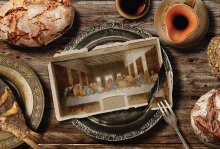
While they were eating, Jesus took a loaf of bread, and after blessing it, he broke it, gave it to the disciples, and said, “Take, eat; this is my body.” Then he took a cup, and after giving thanks, he gave it to them, saying, “Drink from it, all of you; for this is my blood of the covenant, which is poured out for many for the forgiveness of sins.”
— Matthew 26:26-28
CLIMBING ROCK HILLSIDES and wading across gurgling streams lined with thistles, a friend and I walked the Jesus Trail in Galilee a few years ago. After about 8 miles of vigorous hiking each day, the trail led to a hostel or home with a hot meal we shared with other travelers. Our common identification with Jesus on this journey from Nazareth to Capernaum made these bread-breaking events seem to us almost like a “Lord’s Supper”! We were strangers from different countries, but our hunger and our common passion for walking where Jesus walked drew us together.
If eating together helps create a bond between diverse people, what compelled the Apostle Paul to write these words to his house churches in the city of Corinth: “Now in the following instructions I do not commend you, because when you come together, it is not for the better but for the worse.” (1 Corinthians 11:17)?
How does eating a bread cube and drinking a swallow of juice with other church members make things worse in the congregation? What divisions are keeping people apart from each other? Let’s dig into the context.

I BEGIN IN the garden, which sounds biblical but is literal. It’s the day after the spring equinox, and I’m standing outside the Basilica of the National Shrine of the Immaculate Conception in Washington, D.C. The National Shrine is the nation’s largest Roman Catholic church. It’s stuffed to the vaulted ceilings with religious art, but I’m not here for the soaring mosaics and gilded icons.
What I’ve come to see — the Shrine’s Mary garden — turns out to be underwhelming. A statue of the Virgin presides over an empty reflection pool; the garden’s central fountain is also dry. The circular stone terrace is flanked by cherry trees and dormant bushes. The rose bushes are pruned back, and the tulips have yet to open. Except for cherry blossoms unfurling overhead amid a hum of bees, much of the garden still sleeps from winter. I expected a profusion of tangled plants and lush greenery, but this early in the season, nothing much is blooming.
I came to the garden looking for evidence of a movement. Pope Francis’ 2015 encyclical “Laudato Si’: On Care for Our Common Home” called for a global ecological conversion. Inspired by a faith that views humans as Earth’s caretakers, and guided by the science behind native gardening, Catholics around the world have heeded the pope’s call by planting native habitats. Parishes, backyards, and schools are restoring land with local species. Some habitats take the form of Mary gardens: devotional spaces that both honor the Mother of God and enhance biodiversity. Other habitats convert manicured landscapes into pollinator gardens.
The gardeners who tend these spaces range from Girl Scouts to a pair of Instagram-savvy nuns; what they share is a belief that planting native species is a practical way to integrate their faith and environmental values — and to respond to the climate crisis.

This article comes by way of Empowerment Avenue, a nonprofit that works to normalize the inclusion of incarcerated writers and artists in mainstream venues by bridging the gap between them as a path to decarceration and public safety. — The Editors
IN A DIMLY lit room, Noah sits hunched over his half-finished masterpiece. The canvas comes alive under his skilled hand, revealing the weathered face of an old field worker — the grandfather of a dear friend. Every stroke tells a tale of resilience, etching lines of wisdom and hardship that speak to a life often overlooked. As the evening unfolds, Noah’s focused concentration becomes a beacon, drawing curious onlookers who gather around to witness the birth of art.
This is how I think of Bonifacio Alcantar-Maldonado, who I know by his prison handle, “Noah.”
Known outside by his childhood nickname “Junior,” Alcantar-Maldonado is incarcerated at the Washington Corrections Center in Shelton, Wash., where I am serving a life sentence. His life is now defined by two cruel political realities — heartless immigration policies and harsh criminal laws. His story illustrates the waste of human potential by a politics that promotes fear of those struggling in other countries and at home.
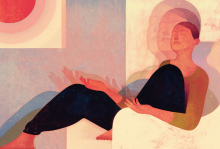
THE INTERIOR CASTLE, the best-known text of 16th-century Spanish saint Teresa of Ávila, is a tour of the inward ways we relate to God, with varying intensity, awareness, and intimacy. In Spanish, the book is simply Moradas, or “Dwellings,” a title I find more appealing and helpful than the English title, mostly because “dwellings” sounds approachable, universal, and less precious.
Teresa was a grounded mystic. She is down-to-earth in her prose, her witty and candid teaching, and her lived experience. It could be argued that every “true” mystic or saint is grounded or has some element of both the active and contemplative life. Teresa strikes me as remarkably and robustly balanced, in a way that her basic reputation as a mystic sometimes betrays. She is notably resolute in both her defense of the reality of “supernatural” prayer experiences and her insistence that this loving movement of God to an individual must then extend into the world rather than curve in on itself. What we might call her grounded nature even extended into her prayer dialogues with Jesus: Once, when complaining honestly to Christ about her many struggles, she heard a response to this effect: “Don’t be troubled; so do I treat my friends.”
Her tart response? “I know, Lord — but that’s why you have so few friends!” In many of her waking days, she worried that Christ has so few “good friends,” and tried to encourage her contemporaries to become better friends of God. But she is clear-eyed and honest about the things that stand in the way of that friendship, from within and without.
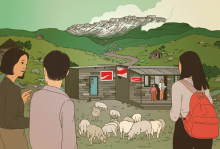
TO CROSS THE border into Lesotho — a landlocked, mountainous country surrounded entirely by South Africa — my friends and I rented a 4x4 and drove up the icy Sani Pass. We switchbacked up one of the most dangerous roads in the world and almost skidded off the cliff.
Slightly shaken but unscathed, we experienced time stretching as we drove through the pastoral city of Mokhotlong, dotted with thatch-roofed mud-and-stone huts. Herds of sheep, in no hurry to make way, blocked the dirt road.
We walked along the deserted street, admiring handicrafts at a rug shop before popping into a grocery store. I was surprised when a Chinese couple greeted us from behind the counter with a warm, “Ni hao.” As my friends and I spoke with them in rudimentary Mandarin (four of us were Chinese American, the fifth was white American), I learned that they had been living in Mokhotlong for many years, raising a family while running the store. We shared a laugh about the unlikelihood of Chinese people finding one another in these hinterlands and, after buying a couple of sodas, went on our way.
Down the road, we discovered another grocery store, staffed by a Chinese couple from a different province in China. What a wild fluke, I thought, that such an isolated town would have two Chinese-owned markets! I soon learned that it wasn’t a fluke at all — Chinese people are present in virtually every nation in Africa, whether as contracted laborers or as informal migrants. Since July 2008, when I visited Lesotho while living in South Africa for two months, the Chinese population in Africa has increased to more than 1 million, including large populations in South Africa, Madagascar, and Zambia but also scattered throughout smaller communities in South Sudan, Togo, and Senegal.
The awe of meeting Chinese people in rural Africa prompted me to examine my family’s migration story and my sense of otherness in the U.S. My parents left Hong Kong to come to the U.S. for college, planting roots here for the freedom and opportunities that didn’t exist back home. Shortly before I was born, they became Christians through a Chinese immigrant church in the Bay Area. When I was 3 years old, we resettled near the University of Iowa, where my dad worked as a cardiologist.
While my parents were members of a small but vibrant Chinese church, by junior high I started attending a large, white, evangelical church where I could fully understand the English language worship service and have peers my age. Bathed in a white-dominant environment both at school and at church, I subconsciously believed that my differences made me inferior and that white male theologians were the arbiters of true Christianity — after all, they were the only people preaching or quoted from the pulpit. This led me to “the misguided belief,” as Grace Ji-Sun Kim writes, “that white knowledge, theology, and spirituality were far greater than anything we had ever possessed.”
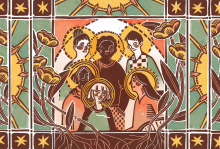
THE PAST DECADE has been replete with calls for the church to examine the barriers it often places between spiritual community and racial minorities, women, and LGBTQ people. While that work is ongoing, Christians with disabilities are issuing and answering a call of their own: to embrace a vision of healing and wholeness that includes people of all abilities.
As Rebecca Holland set out to find a career as a young adult, she felt that her gender, her Filipino ethnicity, and her visual impairment were seen as barriers to her calling. After facing discrimination and being told her disability would prevent her from being a teacher, she went on to gain certification in teaching English for middle and high school, an accomplishment of which she is proud. But then she felt the call to ministry, and the journey began again. In seminary, still smarting from the discrimination in her first vocation, she said she did her best to hide her disability. On top of discouraging attitudes about her call, Holland said she faced an added layer of alienation when Christians would tell her that if she had faith, her physical eyesight could be restored.
Holland’s story of facing discrimination, discouragement, and harmful expectations of healing echo the stories of many disabled Christians and their advocates. And they are urging the church to examine its assumptions about disability, healing, and inclusive practices.
In her first church internship, Holland let people think she was absent-minded when she missed visual cues and clumsy when she knocked things over (because she was walking without her cane). She made up excuses for not driving and went without the accommodations she often needs, like large-print text or screen readers. When it was discovered that she was hiding her disability, she said her mentor was profoundly disappointed in her. Her ministry would be hindered, the mentor said, not because she had a physical disability but because she was living a lie.
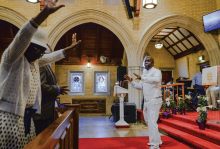
MANY CONSIDER LOUISIANA ground zero for the country’s most pressing environmental problems. The risks of living in a state long nicknamed “Sportsman’s Paradise” continue to mount as worsening, climate change-fueled hurricanes threaten its degrading coastlines, which slip away with rising tides. Meanwhile, an ongoing industrial boom endangers the health of residents living along the fence line of some of the major fossil fuel plants that help drive global warming. But for two quite different church communities — one deep in Louisiana’s countryside and the other in the state’s most populous city — the risks present an opportunity to model what’s needed for a resilient and faithful future.
Tucked in the rural remains of Louisiana’s plantation country, just under 500 people, most of them Black, call the small town of Convent, La., home. The 300-year-old community, situated about 50 miles west of New Orleans on I-10, moves with the bend of the winding Mississippi River, which cuts through the entirety of St. James Parish. Convent serves as the parish seat, and many of the families date back generations, descending from people who were enslaved on sugarcane and indigo plantations.
But people aren’t the only ones who reside there. Some of the wide swaths of land once used for plantations began to be sold to chemical companies in the mid-to-late 1900s. On the eastern end of Convent, a trio of industrial plants neighbor each other, spewing pollution. The coal export facility, fertilizer manufacturer, and chlorine manufacturer each silently release their own toxic mix of hazards into the air — and Convent residents like Rev. Roderick Williams breathe that air every day.
Williams believes his neighbors have suffered as a result, as cancer has spread throughout his community and others in St. James while chemical plants proliferated. It’s challenging to attribute a single cancer case to environmental pollution, but Louisiana Tumor Registry data shows that at least one census tract in St. James has a significantly higher rate of cancer than much of the state.
Williams’ hometown of Convent and the rest of St. James Parish sit in the heart of Louisiana’s chemical corridor, an 85-mile stretch of the Mississippi River running from Baton Rouge through New Orleans. The heavily industrialized swath — forged through the most generous property tax exemption program in the nation — has garnered the infamous nickname of “Cancer Alley” due to concerns about the health impact of the more than 200 industrial plants scattered there. A 2021 ProPublica report found that “Cancer Alley” was one of the country’s largest hotspots for toxic air.
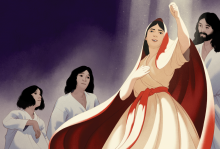
MOST CHRISTIANS TODAY do not understand the life and teachings of Jesus as a broad vision of daring nonviolence. But scripture gives convincing evidence for this: The gospel of Luke presents Jesus as the God of peace who comes among us in total poverty into our impoverished world of war and empire, who brings with him God’s reign of peace and nonviolence, and who invites us to follow him on the path of love, compassion, and justice. With his birth, we hear the angels announce the coming of peace on earth.
Jesus, the greatest peacemaker in history, marked the path of peace toward Jerusalem, where he confronted imperial injustice and called us to learn the things that make for peace; he endured rejection, betrayal, torture, and execution in the holy spirit of nonviolence, and rose to offer his gift of peace and send us out all over again on his path of peace.
How did Jesus learn all this? Luke’s gospel offers an amazing answer. The writer presents Mary, Jesus’s holy Jewish mother, as his teacher of nonviolence.
Luke tells the story of Mary’s journey as three movements of creative nonviolence: the first, the Annunciation as a story of contemplative nonviolence, which leads to the second, the Visitation as the story of active nonviolence, which leads to the third, the Magnificat as the vision of prophetic nonviolence.
Movement 1: Contemplative nonviolence
THE ANNUNCIATION IS a scene of contemplative prayer in which Mary communes with the God of peace; in that silence and stillness, she encounters, and is ready for, God. Jesus learned this from his mother. We will see this in Jesus’s first public appearance when he sits by the Jordan River after his baptism and, in that contemplative peace, hears the God of peace call him “My beloved,” which sets him on his journey.
The first lesson of Lucan nonviolence is to sit in silence and solitude, in contemplative prayer, to open ourselves to God, to listen for God, and to be available if the God of peace chooses to speak. As Mary would have known, the first step in a peaceful life is to spend time in peace with the God of peace, to let God speak to us, to be ready if God sends us forth as peacemakers into the world of war.
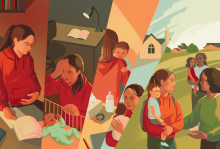
FIVE YEARS AGO, Madelynn Meads was pregnant and stuck between worlds.
Her high school in Leander, Texas, was a new school, and it had never been known to have a teen mom. Her church, where she’d been active in the youth group, suddenly couldn’t find a place for her. She didn’t fit in with the youth group anymore, but the church wouldn’t include her in its ministries for moms either. She’d lost the privilege of a relatively carefree youth without gaining the respect and spiritual investment often offered to young adults and new moms. As a pregnant 16-year-old, Meads said it felt as if the consistent message was, “You’re not a real adult or a real mom.”
Meads, like other teen moms, had fallen into a hole in the social fabric. She didn’t have the support available to teenagers carrying the hopes and dreams of their parents, or to new moms carrying the hopes and dreams of the next generation. Instead, she became part of a statistic, one that schools, government, and nonprofits are working to shrink.
In public discourse, teen pregnancy, poverty, and other adversity often go hand in hand — high school dropout rates for teen moms hover around 50 percent, and few go on to complete higher education. But advocates say that has less to do with the additional responsibility of a baby and more to do with the phenomenon Meads experienced at her church. The moms are no longer the kinds of teens targeted for scholarships and other educational opportunities. Traditional school schedules don’t work with baby schedules, and they can’t meet the time demands of most extracurriculars. If they want the kind of jobs that can help them raise their children in financial security, they must make it through a gauntlet of challenges to get there.
School systems sometimes have specialized services for teen parents to help them finish high school, and staff say they also have to help the teens renegotiate their place in family systems and community. For some Christian ministries, these extra challenges are opportunities to show the teens that there’s a secure, unconditional place for them in God’s family, with all the support to go with it.
Meads found those supports with YoungLives, a branch of YoungLife, a global Christian youth ministry. A YoungLives mentor reached out and gave her a place to belong, to be fully mom and fully teenager, both fun-loving and abundantly capable of facing the huge responsibilities that lay ahead. Instead of struggling to belong, she said, the message changed to “Let’s still have fun and let’s love God.”
Meads recently graduated from Texas A&M University and is getting her teaching certificate. During summers, she volunteers with YoungLives to try to give other teen moms the experience that made such a difference for her.
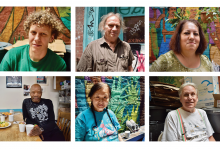
“CATHOLIC WORKER” is shorthand for a movement, a place of hospitality, and a one-penny newspaper started by activist visionaries Dorothy Day and Peter Maurin in the early 1930s in New York City. They imagined urban and rural communities where poverty and loneliness could be alleviated by compassion, connection, shelter, and meaningful work rooted in the teachings of Jesus’ Sermon on the Mount. Catholic Workers are also the people who dish soup, pour coffee, sweep floors, and work for peace at more than 100 loosely affiliated Catholic Worker houses around the world.
Kris Brunelli has been involved in Catholic Worker communities since 2011 when she started serving soup in New York City’s East Village. She met her husband, Marcus, while they were live-in volunteers at the Denver Catholic Worker. Now the two live in Harlem and volunteer at two Catholic Worker houses of hospitality: St. Joseph House and Maryhouse. Marcus is one of a dozen St. Joseph Catholic Workers that Brunelli interviewed for this story.
Between the clang of ladles and the splash of dishwater, community is born and reborn each day. Although people experiencing hunger and homelessness come to St. Joe’s for obvious needs, everyone who walks in the doors needs something. “We volunteers need community — need it just as much, if not more, as the guests who come and eat,” Brunelli says. “We would be lonely without it — lost, even.” — The Editors
Hideko
AT 8 IN the morning, my husband and I knock on the graffiti-splattered, candy-blue door. Most Mondays, alongside other St. Joseph Catholic Worker volunteers, we help serve breakfast to roughly 80 people. Since 1968, off First Street and Second Avenue in the East Village, people have found community.
“Come in! Come in!” Hideko says.
Five feet tall, a black braid down her back, she smiles over her shoulder. “The boss” several days a week, Hideko asks if we want to help make sandwiches — and heads back to the door when someone else knocks.
She stays busy. Originally from Japan, she’s worked on the Japanese translation of Keeanga-Yamahtta Taylor’s 2021 edition of From #BlackLivesMatter to Black Liberation, as well as for Democracy Now! Japan, and regularly organizes protests against U.S. military bases in Okinawa. She is “stubborn.” She says, “you have to be to do this work.”
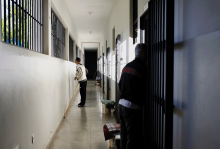
WHEN GRAZIELA MARIANO'S former partner found out that she was in a relationship with someone else, he flew into a rage and attacked her. “We lived together for 13 years. He didn’t accept the breakup,” the 34-year-old Brazilian said. In defending herself, she ended up killing him.
Investigators eventually traced his death back to her. Mariano is waiting for her final sentence behind bars in the eastern city of São João del-Rei. But this jail, run by the Brazilian nonprofit Association for Protection and Assistance of Convicts (APAC), is not an ordinary penitentiary. “Theoretically, we’re in prison. But we’re not handcuffed and there are no weapons,” Mariano said.
In the 68 facilities that the nonprofit manages across Brazil, APAC implements a model in which inmates run aspects of the prison themselves. They wear their own clothes, make their own food, and oversee security and discipline. Referred to as recuperandos (“recovering persons”), prisoners are called by their name rather than by a number. Mariano, a former trainee nurse, works at night distributing medicine to fellow prisoners.
Camila Kersul, a psychologist who offers support to the more than 400 inmates at APAC in São João del-Rei, said, “APAC is essentially about offering dignity to inmates. The idea is to save the person’s identity to boost their self-esteem.”
Created by a group of Brazilian Catholics in the early 1970s, the acronym originally stood for Amando o Próximo, Amarás a Cristo (“Loving thy neighbor, thou shalt love Christ”). Christianity remains at the heart of the nonprofit’s philosophy. “God is the source of everything,” reads the final guiding principle of APAC’s decalogue. Each section of an APAC prison has a prayer room with Bibles and a cross where inmates are encouraged to renew themselves and take time out for reflection when they feel overwhelmed.
Mariano was delighted to move to the APAC facility eight months ago. She spent more than a year in a traditional prison: “I was pepper-sprayed. Food came with cockroaches. It was chaos, and guards were very cruel.” Not once was she permitted to see her three children, ages 6, 9, and 15. In APAC prisons, family ties are part of a prisoner’s rehabilitation. “Here, I arrived on a Tuesday and on the Sunday, I saw my family,” she said.

GROWING UP, I didn’t understand why boys obsessed over girls. “Oh, you will when you’re older,” my dad kept telling me into my early 20s. Only then did I confront what I should’ve known long ago: I’m gay — but not just gay. I am romantically, but not sexually, attracted to men. My father promised that (hetero)sexual desire came with manhood, so am I less of a man?
Many conservative Christian marital counselors and sex manualists have implied that the answer is “yes.” John Eldredge, author of Wild at Heart, wrote that men “come alive” when they have a “a beauty to rescue.” In The Act of Marriage, Tim and Beverly LaHaye wrote that men’s “need for romantic love is either nonexistent or minimal.” Willard F. Harley Jr., in His Needs, Her Needs, wrote that sex is the “first thing [men] can’t do without.” Stephen Arterburn and Fred Stoeker, in Every Man’s Battle, wrote that “maleness” is heterosexual desire. Their message is clear: Sex is essential to God’s vision for manhood.
But every person can live a full, godly life without sex and romance, whether one has desires for both, either, or neither. For many asexual believers, both secular and so-called Christian understandings of sexuality have been insufficient and harmful to them — and to everyone. Perhaps understanding asexuality can lead Christians toward a more inclusive, beautiful, and faithful set of sexual ethics.
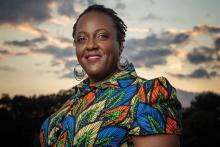
WHEN I WAS 8 years old, I fried an egg on the street. Well, I tried to fry an egg on the street. It had been a particularly brutal summer in Florida. On the days when the playground slides were too hot to go down, my mom would say, “It’s hot enough to fry an egg on the sidewalk!” I kept my eyes glued to that splattered yolk for two hours until a car tire brought the grand breakfast experiment to an end. Frying eggs on sidewalks was how I learned to conceptualize extreme heat.
When it comes to describing climate change urgency in Black communities, Heather McTeer Toney taps into something simple: streetlights. In Before the Streetlights Come On: Black America’s Urgent Call for Climate Solutions, she writes that when she was growing up, kids could play all day outdoors, but they had to be home “before the streetlights came on.” As twilight settled in and streetlights started to flicker, kids would call out, “Hurry up, we ain’t got all day!”
“Right now, that same call to action is carried in the waves of massive hurricanes, on the winds of devastating firestorms, and in the uncharacteristic heat of winter,” McTeer Toney writes. Using a familiar metaphor, she issues a call to action of her own.
Climate change and environmental justice is not foreign to McTeer Toney or the communities she writes about. At age 27, she was the first female and youngest person to serve as mayor of Greenville, Miss., where she was born and raised. As mayor, she brought the city out of debt and established sustainable infrastructure repair. For three years, she led the Environmental Protection Agency for the southeastern United States. While at the global nonprofit Environmental Defense Fund, she addressed environmental policy and community organizing within and beyond the U.S. This spring, McTeer Toney became executive director of Beyond Petrochemicals, a campaign to stop the rapid expansion of petrochemical and plastic pollution, particularly in the Ohio River valley and along the Gulf Coast.
McTeer Toney and her family attend Oxford University United Methodist Church in Oxford, Miss. I spoke with her by phone about her work, her book, and the hope her faith demands. — Christina Colón
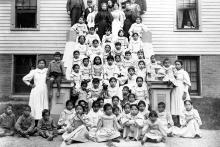
WHEN POPE FRANCIS visited Canada in July 2022, he said he was “deeply sorry” for the abuses inflicted upon peoples from First Nations by more than a century of Catholic-run residential schools. Francis decried the ways “many Christians supported the colonizing mentality of the powers that oppressed the Indigenous peoples,” which resulted in “cultural destruction and forced assimilation.”
To his credit, the pontiff acknowledged that his apology was not “the end of the matter,” and that serious investigation of what was perpetrated and enabled by the church was necessary for the survivors of the schools “to experience healing from the traumas they suffered.”
In the United States, the Seneca Nation is paving a path toward that healing process in their homelands, in particular from harm caused by a Presbyterian-run residential school.
A month after the pope’s apology, Matthew Pagels, then-president of the Seneca Nation — which historically inhabited territory throughout the Finger Lakes and Genesee Valley regions of New York — announced a new initiative to compile and catalog a list of residential school attendees.
To lead the effort, Pagels tapped Sharon Francis, a member of the Wolf Clan of the Seneca Nation and program coordinator at the Seneca Nation crime victims unit. Her passion, she said, is helping her communities heal from personal, intergenerational, and historical traumas.